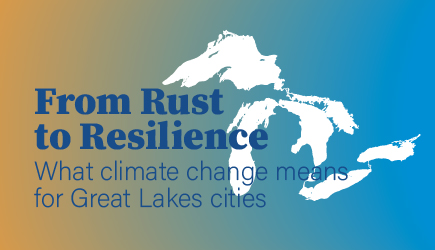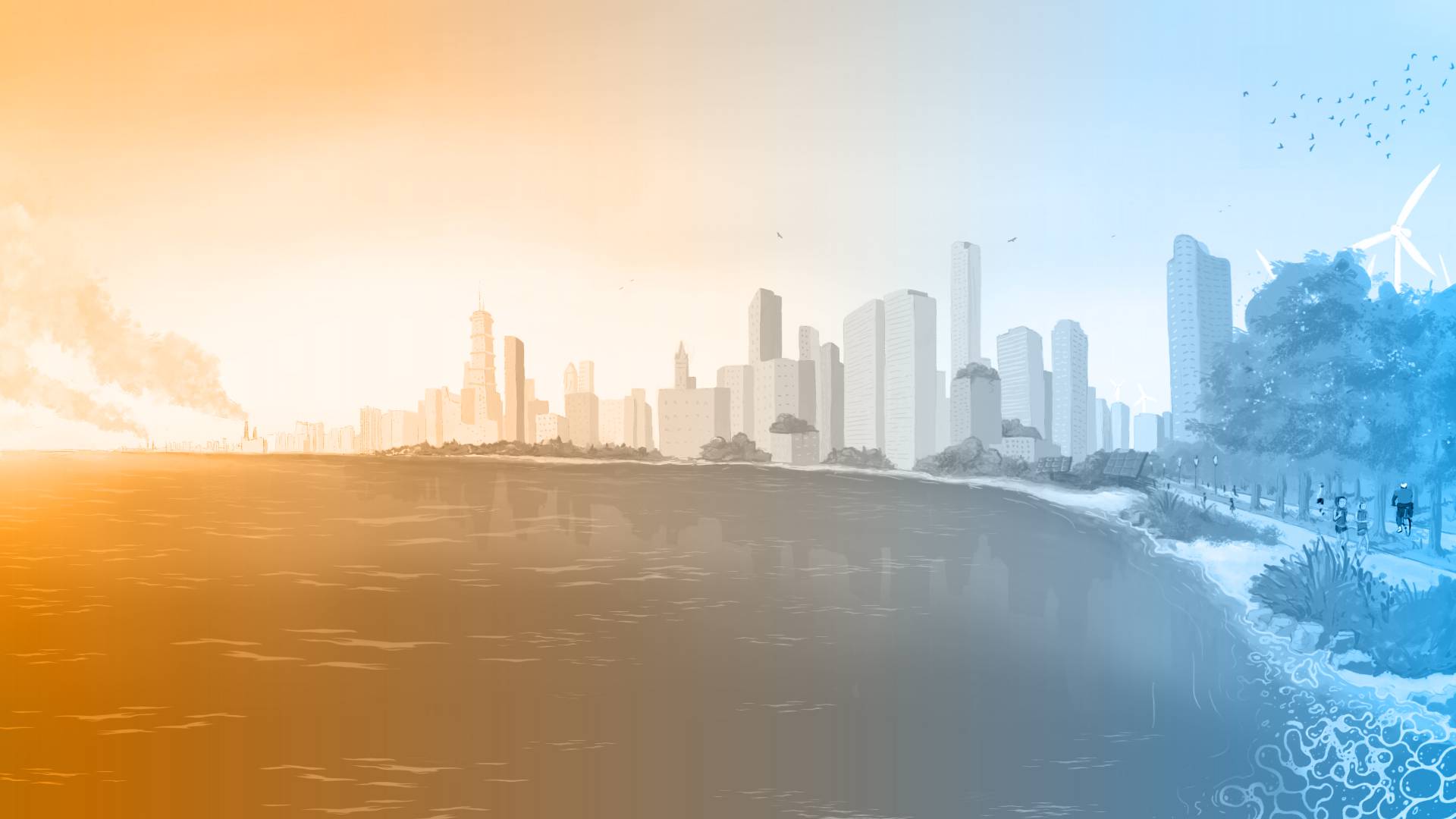
By Kari Lydersen, Ensia
This article is part of the Pulitzer Center’s nationwide Connected Coastlines reporting initiative. For more information, go to pulitzercenter.org/connected-coastlines-initiative.
For all stories in the “From Rust to Resilience” project, including the Great Lakes Now monthly show, click HERE.
In the 1960s, the U.S. was enjoying an unprecedented economic expansion, and the Great Lakes region was humming with industry supplying materials to build a growing nation with well-paying union jobs and an increasingly comfortable lifestyle for a large middle class.
At the same time, the lakes themselves and many of the tributaries running into them were in tough shape, thanks in large part to the steel mills, manufacturing plants and other enterprises that had sprouted up along their banks and shores in the wake of the Industrial Revolution.
Across the region, industry was dumping waste into the lakes and rivers and spewing pollution into the air with seeming impunity. The oil-slicked Cuyahoga River, which empties into Lake Erie, famously caught fire multiple times over the decades.
Watch Great Lakes Now’s segment on the most famous Cuyahoga River fire:
API key not valid. Please pass a valid API key.
The 1970s brought rapid changes on the environmental front: The U.S. Congress passed the Clean Water Act, President Richard Nixon created the U.S. Environmental Protection Agency and public awareness of environmental issues skyrocketed with the founding of Earth Day. Canada similarly adopted legislation aimed at assessing and limiting environmental pollution.
But not long after new regulations began compelling industries to clean up their act, emerging forces such as a shrinking market for steel, growth of global trade and migration of manufacturing to the Sun Belt started reshaping the Great Lakes region’s economy. Competition from foreign manufacturers caused a rapid decline in U.S. industry in the early 1980s, and cities like Gary, Detroit, Cleveland and Buffalo lost jobs and population. Buildings stood vacant, and infrastructure fell into disrepair. The region took on the name “Rust Belt,” a nod to its deteriorating physical and economic condition.
Today, the Great Lakes themselves and their tributaries are in many ways healthier. Great Lakes Fishery Commission communications director Marc Gaden, who has spent much of his life on or near the Great Lakes, says the changes over the past half century have not been unequivocally positive, “but certainly the trajectory is very encouraging. Instead of viewing the Great Lakes as a repository for pollution, we shifted to thinking of it as a source for clean water, wholesome food and recreation.”
Watch Great Lakes Now’s segment “Kinnickinnic River Restoration”:
API key not valid. Please pass a valid API key.
In tandem with this ecological recovery, many Great Lakes cities and towns are enjoying an economic renaissance. And in many cases they’re leveraging their ecological assets to do so — turning once-fetid and industrial rivers and lakefronts into amenities, and building new economies based on information technology, health care, tourism and other post-industrial sectors.
In 2017, Business Insider calculated that if the Great Lakes region was a country, its economy would be the third largest in the world, with education/health and trade being the largest sectors, making up a combined third of the economy.
However, just as municipalities are beginning to heal from economic shifts and traumas, they face yet another threat: climate change. From the headwaters of the St. Lawrence River in the east to the shores of Lake Superior in the west, the communities that grew up along these magnificent lakes and weathered so many transitions along the way are bracing for what could be the biggest transition of all.
Highly Vulnerable
Great Lakes cities don’t have to worry about sea-level rise and hurricanes to the extent cities do on the coasts. However, as Side Effects Public Media reports in this series, the region is highly vulnerable to the heat waves, flooding and severe storms expected to increase with climate change.
And cyclical water level increases are causing challenges.
Watch Great Lakes Now’s segment “Vanishing Shorelines:
API key not valid. Please pass a valid API key.Aging infrastructure and sewer systems that combine stormwater with wastewater make Great Lakes municipalities especially susceptible to climate change impacts. And agriculture, which comprises a significant part of the regional economy, could be severely harmed.
The Great Lakes region already has warmed at a higher rate than the U.S. as a whole, and the mean annual temperature could increase another 2.7 to 7.2 °F (1.5 to 4.0 °C) by century’s end, according to the Environmental Law & Policy Center (ELPC), a public interest legal and business innovation organization.
Precipitation has increased close to 10 percent in the Great Lakes region since 1901, according to the ELPC, a rate that exceeds that of the U.S. overall. And precipitation is expected to become even heavier in winter and spring and scarcer in summer, potentially fueling a cycle of flooding and drought.
Climate change also raises new opportunities, however. Efforts to curb emissions of climate-changing greenhouse gases, and to adapt to climate change impacts, are expected to catalyze job-creating investments in green infrastructure, renewable energy, building weatherization and more.
“Climate change is a constant, and it affects every single issue,” says Joel Brammeier, president and CEO of the Alliance for the Great Lakes. “We can’t solve it by focusing on the lakes. We need a rational approach to dealing with our carbon problem. And, in the meantime, we need to adapt to our changing conditions in the Great Lakes.”
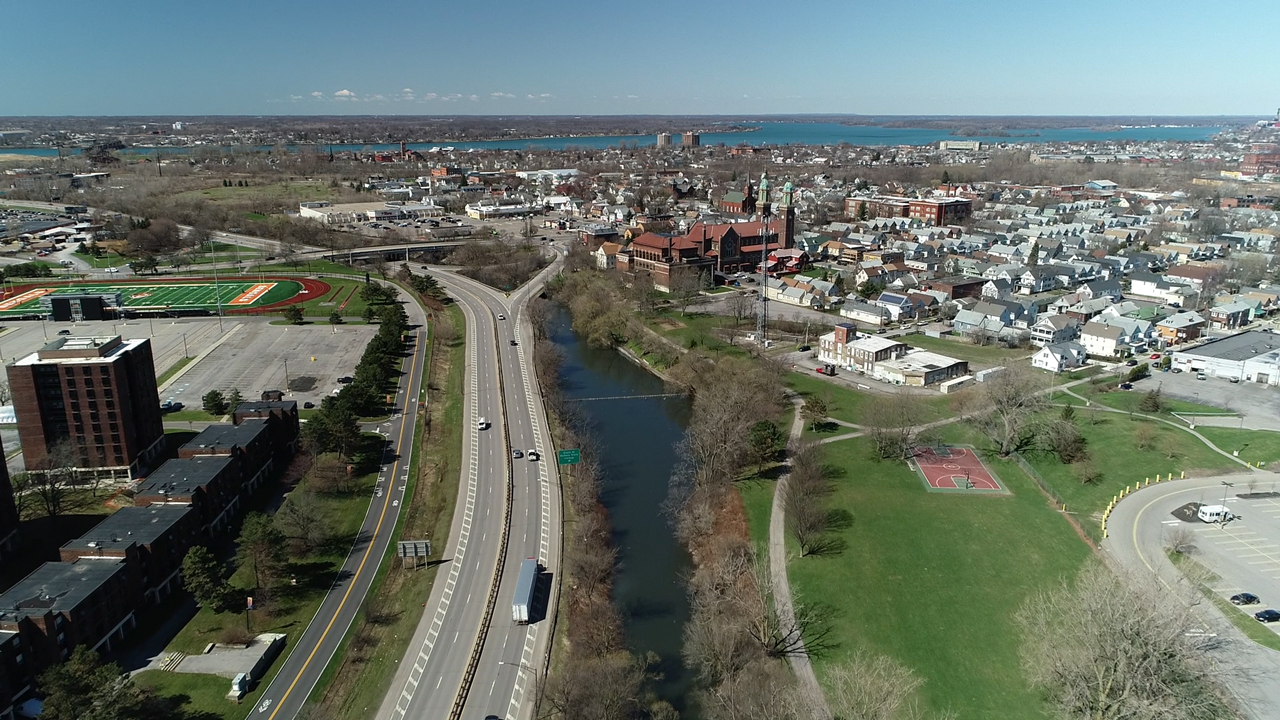
Climate Refuge?
A 2017 Urban Institute report on the Great Lakes region noted that while the population in some major Great Lakes cities may be declining, it’s also becoming more diverse in age, race and ethnicity.
Some of the Urban Institute’s recommendations for economic development and stability go hand in hand with protecting the lakes: creating new avenues for civic participation and engagement, revamping infrastructure for water and utilities, creating jobs, and investing in young people.
As climate change makes other parts of the U.S. increasingly uncomfortable and inhospitable, some speculate that the Great Lakes region could become a “climate refuge.” The appeal? Temperatures are relatively moderate and the lakes themselves provide ample freshwater — an increasingly valuable commodity sometimes referred to as “blue gold.”
“For all of these cities on the Great Lakes, central to their success economically are the lakes and rivers that come into them,” says David Ullrich, who has been working on Great Lakes issues for a half-century, most recently as advisor to the Great Lakes and St. Lawrence Cities Initiative. “It’s not about heavy industry like it used to be; it’s an amenity and quality of life issue. Great Lakes cities have a tremendous advantage in terms of the access to water — adequate drinking water and recreational water.”

Green Without Envy
While agriculture has long been fundamental to the Great Lakes region’s economy and culture, modern farming practices have taken an environmental toll that has consequences for the cities they feed. Fertilizer that washes off sprawling corn and soybean fields and into waterways can cause serious problems as it feeds harmful algae that choke waterways of oxygen, sometimes killing fish and making beaches unusable.
Watch Great Lakes Now’s segment “Toxic Algae and the Climate Conundrum”:
API key not valid. Please pass a valid API key.As Great Lakes Now reports in this series, Lake Erie saw its worst toxic algal bloom in recorded history in 2011, and in 2014 half a million people in Toledo were told to avoid drinking tap water for 72 hours because of contamination from toxic algae. Green Bay and other parts of the Great Lakes are also affected.
Unlike “point source pollution” that was curbed by the Clean Water Act, there are still no meaningful regulations to prevent pollution from running off agricultural fields or confined animal feeding operations. The increasingly heavy storms and warmer temperatures coming with climate change are likely to exacerbate the problem.
But, as The Conversation describes in this series, innovative solutions are in the works. Governments and private organizations offer incentives for farmers to create wetland or forest buffers on their land to reduce runoff.
In February, the EPA announced a US$1.8 million federal grant under the Great Lakes Restoration Initiative to help organizations address nutrient pollution, including by developing markets to trade water quality credits. And smart sensors hold promise for providing early warning of impending drinking water impairments.

Deep Trouble
Climate change is also expected to cause increasingly rapid and extreme fluctuations in Great Lakes water levels, a trend we’ve already seen. Within the past decade, the lakes have gone from nearly record low to record high levels.
It’s natural and healthy for lake levels to change over time. But very high or very low levels spell trouble for commercial shipping, recreational harbors and power plants that use lake water for cooling.
Watch Great Lakes Now’s segment “Chicago’s Battered Beaches”:
API key not valid. Please pass a valid API key.
They also contribute to erosion and other problems for people along the shore: In Chicago, as Belt Magazine chronicles in this series, massive waves batter neighborhoods along the shore of Lake Michigan.
Recent high water levels have shorelines, parklands, lakeside trails and even homes disappearing along various other coastlines, including, as Side Effects Public Media reports, one of our newest national parks, Indiana Dunes. As a result, attention is being focused in some areas on revamping coastal infrastructure to prepare for more rapidly shifting and drastic highs and lows.
“What used to be a 100-year record is now becoming a 10-year norm,” says ELPC executive director Howard Learner. “This affects people’s lives, our communities, our ecology and very much the built environment. Houses and bluffs are collapsing on the eastern Lake Michigan shore. Residential buildings are under siege from higher water levels. We need to rethink shoreline infrastructure and how the built environment can appropriately and effectively function in light of much higher and lower water levels.”
Watch Great Lakes Now’s segment on the Indiana Dunes National Park:
API key not valid. Please pass a valid API key.
Invasive Havoc
The Great Lakes are home to more than 180 non-native species, organisms from outside the region that have established harmful populations. A number of invasive species are thought to have entered the Great Lakes in ballast water carried by ships traveling from the Atlantic Ocean through the St. Lawrence Seaway.
Non-native zebra mussels and quagga mussels have wreaked havoc on cities’ water intake structures and gobbled up the plankton that make up the base of the food chain. Meanwhile invasive sea lampreys latch onto salmon and bass and suck their blood, horrifying anglers and decimating fish stocks.
Watch Great Lakes Now’s segment “Mussel Blasting”:
API key not valid. Please pass a valid API key.
Ballast water regulations in the past 10 years have stemmed the introduction of new invasive species. But warming lake temperatures possible with climate change could exacerbate the problems caused by invasive species already in the lakes, if native species suffer from warmer water while invasive species thrive.
This could have serious consequences for the Great Lakes fishery, which has been valued at more than US$7 billion per year, an important source of income for numerous cities and towns. Public and private agencies have been working hard to stem the tide of invasive species, from lobbying for ballast regulations to mandating boat cleaning to sterilizing sea lampreys. But these efforts will likely need to adapt as climate change shifts the ecological balance.
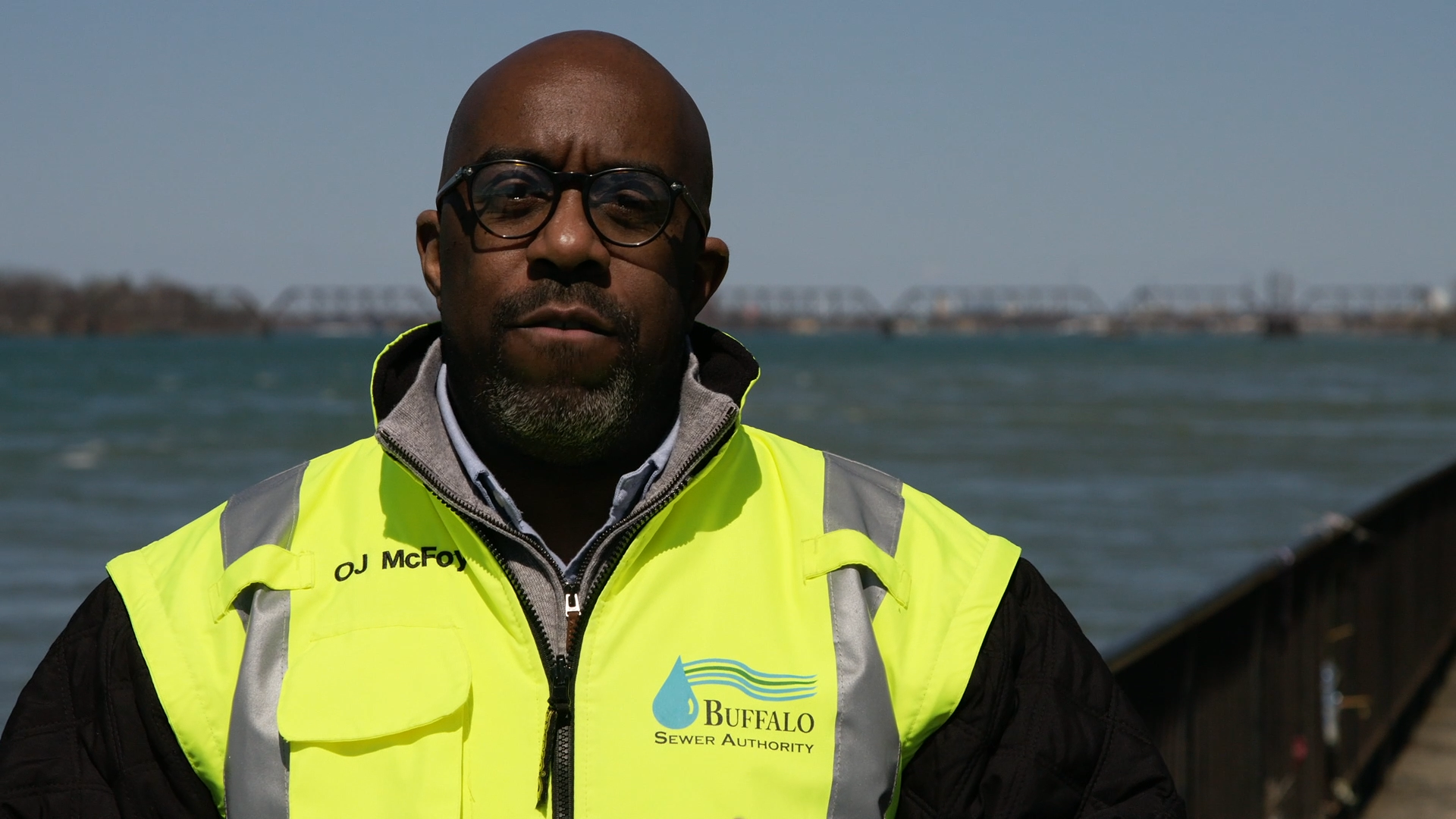
OJ McFoy is the general manager of the Buffalo Sewer Authority.
Overflowing Sewers
When heavy storms overwhelm the combined sewer systems common throughout the region, untreated sewage is released into lakes and rivers. As Side Effects Public Media recounts in this series, this means unsightly and smelly water that can spread disease if people come in contact with it while working, swimming, fishing or boating.
Cities including Milwaukee, Chicago, Detroit and Toronto have worked to reduce stormwater runoff through green infrastructure: permeable pavement, rain gardens, rain barrels and retention ponds that absorb or hold stormwater. As Ensia reports in this series, however, other urban areas such as Duluth and Milwaukee have nearly eliminated combined sewer overflows by upgrading their water management systems.
But climate change will keep heavier rains coming. At the same time, sewer pipes will continue to age and crack, allowing water to infiltrate them and add to the burden.
Watch Great Lakes Now’s segment “Buffalo Rain Check”:
API key not valid. Please pass a valid API key.Too Hot
As the atmosphere warms, past experiences with sweltering temperatures take on new and ominous significance. In 1995, Chicago simmered through a deadly heat wave that killed more than 700 people. Many were elderly or low-income residents, unable to afford air conditioners and afraid to open windows or sleep outside because of crime.
The prevalence of concrete in Midwestern cities amplifies the impacts of heat waves, and heat facilitates the formation of smog, even as air pollution is already a problem across much of the region. These problems are only expected to increase as average annual temperatures climb.
Heat also places extreme stress on the electric grid and power generation as air conditioners suck energy to cool indoor spaces.
To deal with climate change, cities are increasingly developing resilience plans that include emergency measures for heat waves and storms. They are designating cooling centers — public places where people can come to escape soaring temperatures — and identifying people who need well-being checks. And, as The Conversation explains in this series, improvements can also come through aid to help low-income people pay for energy bills and weatherization programs that make buildings more energy efficient.
Power Shift
As MinnPost reports in this series, fossil fuels have long played — and in many instances, continue to play — a central role in powering Great Lakes industries, and have themselves been part of the region’s economic engine. Revamping the energy system is key to both surviving heat waves and other climate change impacts, and reducing the region’s contribution to climate change.
Cities are increasingly experimenting with microgrids, which can disconnect from the larger grid and provide power when heat waves or storms are placing stress on the system. Rooftop solar panels with battery storage can provide energy in an emergency while also sending clean energy back to the grid on a daily basis.
Some Great Lakes cities, including Milwaukee and Chicago, have programs meant to help businesses and residents adopt solar power. The potential for offshore wind power generation in the Great Lakes is also under study. In fact, as reported by Belt Magazine in this series, a wind farm is poised to emerge from the waves of Lake Erie near Cleveland.
Most states have Renewable Portfolio Standards mandating a certain percentage of energy come from clean sources by certain years. Illinois is considering legislation that would call for 100 percent renewables by 2050. These standards are likely to drive policy leading to the construction of more wind farms and utility-scale solar farms, as well as new transmission lines to get the renewable power where it’s needed.
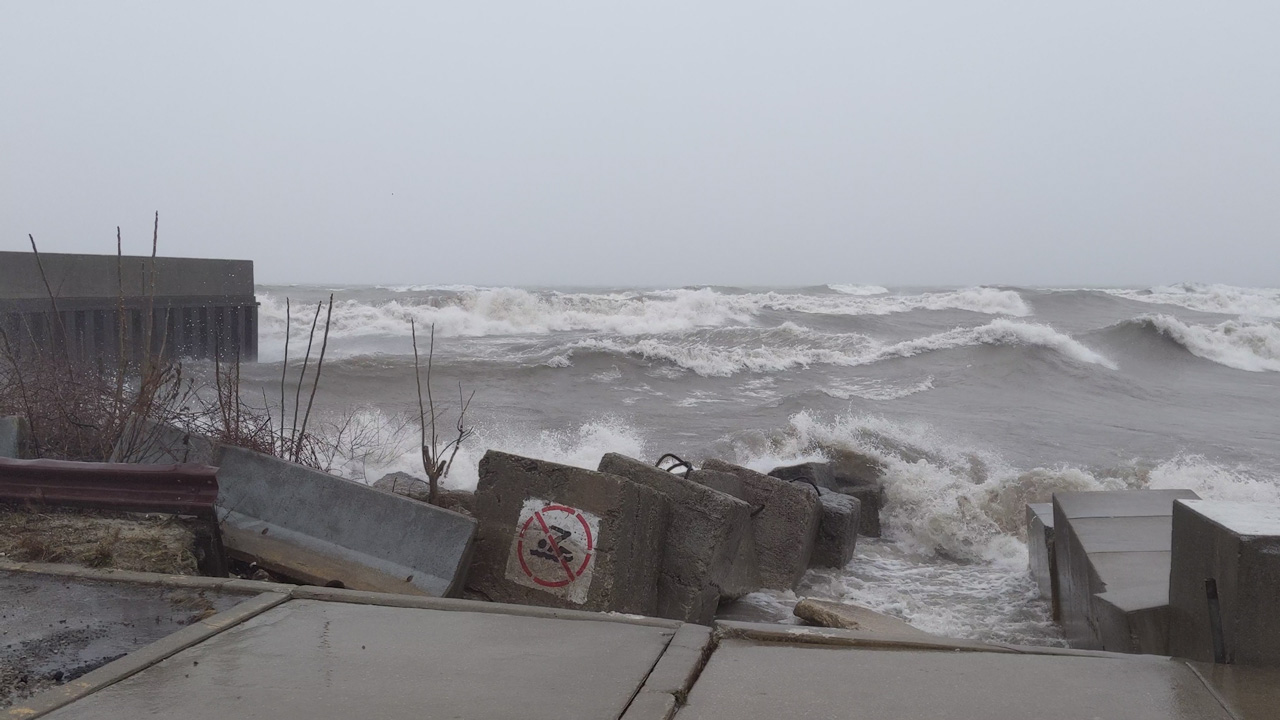
Defining Issue
Worldwide, climate change affects the most vulnerable people the hardest: low-income, rural or subsistence communities who are seeing their fisheries decimated, their livestock starving, their crops withering or their land literally disappearing into the sea. In Great Lakes cities, it is likewise lower-income people who suffer most from climate change’s direct and indirect impacts, as well as from the fossil fuel-driven economy that causes climate change.
Ullrich is among those who think that environmental justice may be the biggest policy and political issue defining the Great Lakes region in the changing years ahead. He attended the Global Water Justice Summit in Detroit in January and says he was inspired to see leaders like Monica Lewis-Patrick from We the People of Detroit drawing connections among struggles for clean, affordable drinking water; access to green space; and economic equity.
In Chicago, Olga Bautista is a lifetime resident of the once heavily industrialized Southeast Side, where the Calumet River makes its way to Lake Michigan. She and her neighbors have long fought with city officials and companies, demanding the area no longer be treated as a “sacrifice zone” and storage site for coal, petroleum coke and other harmful materials.
Instead, they say, there is boundless potential for redevelopment building on the area’s history but with green jobs and infrastructure. They want to see things like renewable energy and training facilities built on former steel-mill sites, and marshes used for bird-watching instead of illegal dumping. They’ve marched in Chicago and Washington, D.C., demanding climate justice and an end to fossil fuel dependence.
All told, the residents of the Great Lakes region today have an immense challenge in dealing with the impacts of the climate crisis, protecting and empowering the most vulnerable, and transitioning to a cleaner energy system to help stem further climate change. But just as people rose to the challenges of the past with incredible engineering feats, there’s clearly abundant potential for innovation, cooperation and change today.
“Now we have the chance to think about what are we going to do, with the workforce, with the land devastated by industry, to think about how we can put our families to work to repair the harm,” says Bautista, who is co-founder of the Southeast Side Coalition to Ban Petcoke, and community planning manager with the Alliance for the Great Lakes.
“When I think about resiliency and sustainability, there also has to be talk about guaranteeing jobs to people, making sure people can get the care they need, that our schools are being funded and are safe. Because our most important resource is our people.”
Watch this behind-the-scenes interview with Kari Lydersen:
API key not valid. Please pass a valid API key.“From Rust to Resilience: What climate change means for Great Lakes cities” is a collaborative reporting project that includes six members of the Institute for Nonprofit News (Belt Magazine, The Conversation, Ensia, Great Lakes Now at Detroit Public Television, MinnPost and Side Effects Public Media) as well as WUWM-FM Milwaukee, Indiana Public Broadcasting and The Water Main from American Public Media.
This project is part of the Pulitzer Center’s nationwide Connected Coastlines reporting initiative. For more information, go to pulitzercenter.org/connected-coastlines-initiative.



